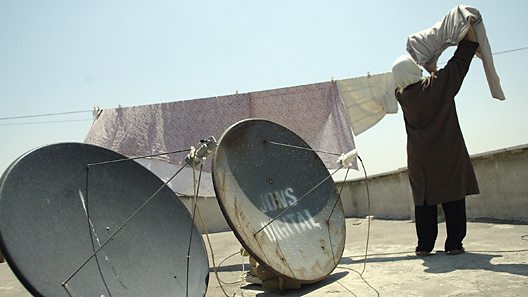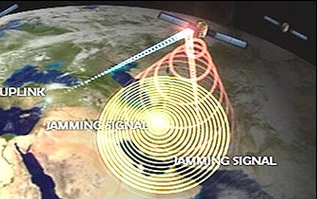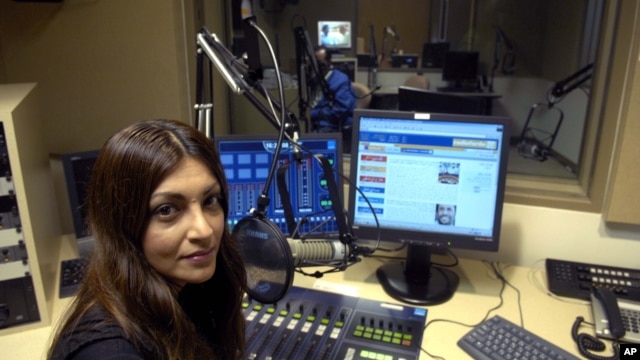Interference leaves broadcasters in a jam
BBC Monitoring 29 Aug 2014

By Duncan Stanworth
Jamming, the term for deliberate interference to radio and TV broadcasts, is a pressing problem for world broadcasters and satellite companies.
It can be particularly acute when political tensions are running high.
Satellite TV jamming has been traced to several countries; including Iran. Shortwave radio jamming, which was a feature of Cold War broadcasting, is still practised - notably by China (pictured above).
Jamming, the term for deliberate interference to radio and TV broadcasts, is a pressing problem for world broadcasters and satellite companies.
It can be particularly acute when political tensions are running high.
Satellite TV jamming has been traced to several countries; including Iran. Shortwave radio jamming, which was a feature of Cold War broadcasting, is still practised - notably by China (pictured above).
How satellite jamming works
There are two main ways to obstruct a satellite signal.
Iranian authorities restrict what domestic audiences can see
Uplink
jamming works by transmitting a powerful, interfering signal on the
frequency which is used to send a broadcast to the satellite.
It can affect viewers across a huge area and cause unintended interference to other broadcasters.
Downlink jamming is localized. It relies on transmitters on the ground, which block the signals beaming down from the satellite to viewers' dishes.
Websites which track the interference speculate about where it comes from. Some say flag poles, which have sprouted in Tehran and other cities, may be involved.
It can affect viewers across a huge area and cause unintended interference to other broadcasters.
Downlink jamming is localized. It relies on transmitters on the ground, which block the signals beaming down from the satellite to viewers' dishes.
Jamming in Iran
Recent reports from Iran say the authorities are stepping up their efforts to stop people watching foreign satellite TV stations by intensifying downlink jamming.Websites which track the interference speculate about where it comes from. Some say flag poles, which have sprouted in Tehran and other cities, may be involved.
Other theories include the use of specially-equipped vehicles and "suspicious" aerials on the rooftops of state-owned buildings.
Some Iranian papers say the strong jamming signals are causing health problems. But the reports of miscarriages and cancers tend to cite anecdotal evidence.
Western broadcasters - including the BBC, Voice of America and Deutsche Welle - have also complained about uplink jamming of their TV programmes in Persian.
Eutelsat, a major satellite firm based in Paris, said in 2013 that "deliberate jamming operations" could be traced to Iran.
But in February 2014, the US waived sanctions on Iran's state broadcaster IRIB after it determined that "harmful satellite interference" was not currently coming from Iran.
In 2012, Arabsat and Eutelsat said uplink interference to Al-Jazeera TV could be traced to Iran and Syria.
At the same time, American and European broadcasters said interference from Syria was disrupting satellite broadcasts "in an arc from Russia through Europe, Central Asia and the Middle East".
In 2011, Mu'ammar al-Qadhafi's Libya was reported to be a source of jamming, but was itself a target.
Some Iranian papers say the strong jamming signals are causing health problems. But the reports of miscarriages and cancers tend to cite anecdotal evidence.
Western broadcasters - including the BBC, Voice of America and Deutsche Welle - have also complained about uplink jamming of their TV programmes in Persian.
Eutelsat, a major satellite firm based in Paris, said in 2013 that "deliberate jamming operations" could be traced to Iran.
But in February 2014, the US waived sanctions on Iran's state broadcaster IRIB after it determined that "harmful satellite interference" was not currently coming from Iran.
Arab turmoil
Turmoil in the Arab world has also spurred the satellite jammers.In 2012, Arabsat and Eutelsat said uplink interference to Al-Jazeera TV could be traced to Iran and Syria.
At the same time, American and European broadcasters said interference from Syria was disrupting satellite broadcasts "in an arc from Russia through Europe, Central Asia and the Middle East".
In 2011, Mu'ammar al-Qadhafi's Libya was reported to be a source of jamming, but was itself a target.
China
Other offenders include China, which has for years jammed Chinese and Tibetan-language radio programmes from the West, including those of the BBC, Voice of America and US government-backed Radio Free Asia (RFA).
China has for long been jamming broadcasts from the West
North Korea jams shortwave broadcasts from RFA and South Korean stations. It is reported to be using Chinese-made equipment.
In Africa, Ethiopia has long been jamming opposition and international broadcasts, while Zimbabwe is said to have used Chinese equipment to interfere with broadcasts from foreign and exile radio stations.
Satellite broadcasters may change or add frequencies, but this relies on viewers being tech-savvy enough to retune their receivers or move their dishes.
But the future may hold high-tech solutions.
Eutelsat's 8 West B satellite, which is due for launch in 2015 and will serve the Middle East, boasts new technology which allows the operator to change the frequency of an uplink signal with no impact on viewers.
Eutelsat says this marks a "major breakthrough in the bid for continuity of service for broadcast signals jammed by rogue uplink signals".
In Africa, Ethiopia has long been jamming opposition and international broadcasts, while Zimbabwe is said to have used Chinese equipment to interfere with broadcasts from foreign and exile radio stations.
Tackling the jammers
Jamming is against the rules laid down by the International Telecommunication Union (ITU), a UN body. But there are few ways to stop it.Satellite broadcasters may change or add frequencies, but this relies on viewers being tech-savvy enough to retune their receivers or move their dishes.
But the future may hold high-tech solutions.
Eutelsat's 8 West B satellite, which is due for launch in 2015 and will serve the Middle East, boasts new technology which allows the operator to change the frequency of an uplink signal with no impact on viewers.
Eutelsat says this marks a "major breakthrough in the bid for continuity of service for broadcast signals jammed by rogue uplink signals".






